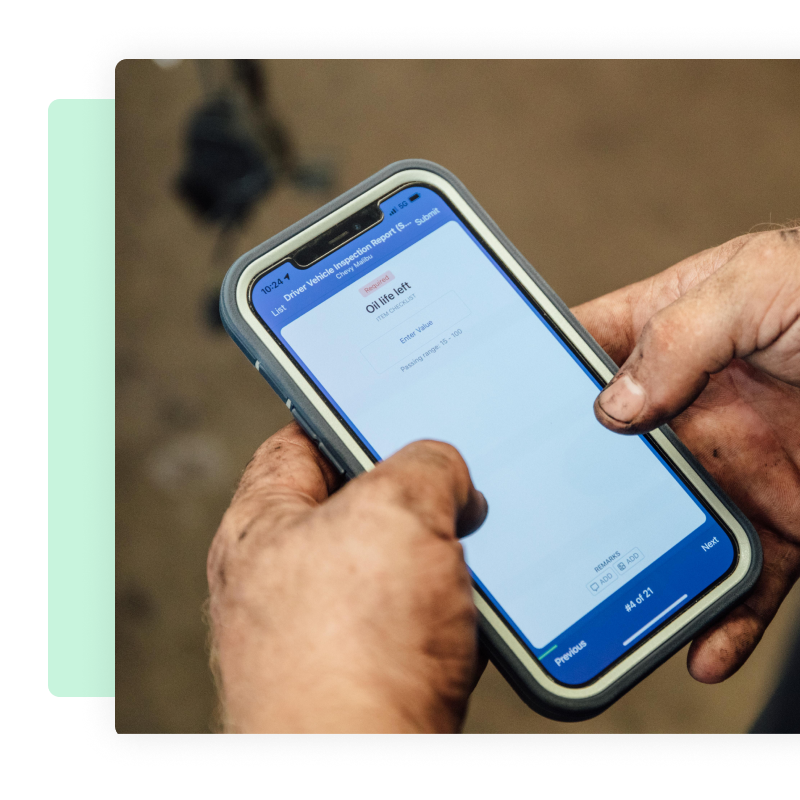Pre-Trip Inspection Checklist for Drivers and Fleet Managers
Daily pre-trip inspections aren’t just a DOT box to check – they’re your first line of defense against costly breakdowns, safety incidents and compliance headaches. Use this guide to strengthen your inspection process, protect your drivers and keep assets road-ready.
Jul 9, 2025
9 min read

Jump to a topic
What is a pre-trip inspection?
A pre-trip inspection is a daily, systematic review of a commercial asset’s safety and roadworthiness. Required by the DOT, it involves checking key systems such as brakes, tires, lights, steering and emergency equipment.
A sound inspection ensures the asset is safe to operate and identifies anything that needs attention before hitting the road. It’s a critical part of CDL training and one of the most effective ways to avoid mechanical failures and safety incidents on the job.
Typical inspection areas include:
- Exterior walk-around
- In-cab systems and controls
- Fluid levels and mechanical components
- Safety/emergency equipment
- Cargo or trailer security
Why pre-trip inspections matter
Pre-trip inspections might seem routine, but they deliver real value across your fleet – saving time, money and stress down the line. These benefits extend to safety, performance, compliance and even your brand reputation.
- Better safety: Spotting issues early, especially with brakes or tires, can prevent serious accidents.
- Fewer delays: Addressing problems before departure keeps schedules intact and customers happy.
- Lower repair costs: Routine checks help catch issues before they escalate into major repairs, which helps to reduce cost per mile (CPM).
- DOT compliance: Staying inspection-ready helps avoid fines and failed roadside checks.
- Longer vehicle life: Daily inspections support safer, more consistent operation, which reduces the daily wear of a failing component.
- Improved fuel economy: Inspections can surface tire or filter issues that may impact fuel economy, helping you take action before performance suffers.
- Driver confidence: Knowing their vehicle is safe helps drivers focus on the road.
- Professionalism: Consistent, documented inspections show your team takes safety and compliance seriously, building trust with drivers, partners and customers.
- Better planning: Inspection data helps inform proactive maintenance and budget decisions, which reduces TCO and improves asset utilization.
Pre-inspection checklist for fleets
A strong pre-trip inspection makes all the difference, especially for CDL Class A vehicles, where requirements are more detailed. We've organized the checklist below by vehicle zone and followed DOT best practices.
It’s designed to cover all major systems to support drivers in meeting compliance requirements, passing their commercial driver’s license test, and most importantly, staying safe on the road.
General vehicle information:
- Vehicle ID
- Odometer reading (record at the start of each day to monitor mileage and support asset utilization tracking)
- Note driver information, including name, employee number and any other relevant identifiers
Engine compartment (engine off)
- Check oil, coolant and power steering fluid levels
- Look for leaks or loose connections on all hoses
- Inspect belts for wear, there should be no frayed edges and they should move no more than ¾" when pressed
- Confirm that the water pump, alternator and air compressor are securely mounted
- Look under the engine compartment for signs of fluid leaks
- Inspect the water pump for leaks and ensure hoses are properly connected
Pro tip
Run your hand along belts and hoses – if they feel soft, brittle or cracked, it’s time to report it. Any damage or looseness can affect the performance of components like the water pump, alternator or air compressor.
Exterior checks
- Ensure lights are working properly, including headlights, brake lights, turn signals, hazard lights and marker lights
- Examine the body for dents, scratches, decal damage or structural defects
- Check for missing or damaged reflectors, reflective tape and license plate lights
- Look under the vehicle for any pooling fluid
Pro tip
Visibility matters when inspecting exteriors. Make sure they're conducted in a well-lit area or with lighting assistance like a handheld flashlight.
Brake system
- Inspect hoses for wear, cracks or leaks
- Check brake chambers for secure mounting and damage
- Test slack adjusters, push rods shouldn’t move more than 1" when pulled by hand
- Inspect brake pads for a minimum thickness of ¼" and look for any oil contamination
- Look for cracked or discolored drums
Pro tip
Always do a "tug test" before hitting the road with trailers. Once your fifth-wheel hitch is locked around the kingpin, raise the landing gear slightly, apply the trailer brakes, ease off the truck brakes and give a gentle pull. If your setup holds steady, you're good to go
Wheels & tires
- Check tread depth: at least 4/32" on front tires and 2/32" on rear
- Confirm tire pressure based on vehicle recommendations
- Look for tire damage or sidewall issues
- Make sure all lug nuts are tight and there aren't any rust trails or cracks
- Check that valve stems are capped and dual tires are evenly spaced
- Examine hub seals for leaks
Mechanical systems
- Check oil level and report if low outside of expected range
- Inspect battery terminals, mounting, and cables for corrosion or loose connections
- Examine engine hoses, tubing, and reservoirs for wear or leaks
- Look for any new fluid beneath the vehicle while idling
- Ensure the fuel tank is securely mounted, free from leaks and has a properly sealed cap
Cab & in-cab systems
- Check horns, windshield wipers, mirrors, heater/defroster and seatbelt function
- Review all gauges: oil, air pressure, coolant temp and volts
- Inspect the windshield for cracks or obstructions to visibility
- Test the brake pedal for firmness and responsiveness – there should be no delay or excessive give when pressed
- Check that the steering wheel moves smoothly, with no excessive play or unusual resistance
- Verify that emergency equipment is on board and includes a fire extinguisher, three reflective triangles and spare fuses
- Confirm that all warning lights (ABS, check engine, battery, etc.) illuminate during startup and turn off appropriately
Pro tip
A tidy cab isn’t just nice to look at;it makes everything from inspections to emergencies easier. Loose items can become hazards while driving and may obstruct access to important controls or safety equipment.
Coupling system (where applicable)
- Inspect the fifth wheel for cracks and proper lubrication
- Ensure the locking jaw is fully engaged around the kingpin
- Check that air and electrical lines are secure, not dragging and don't have any leaks
- Confirm glad hands are properly connected with seals in place
- Make sure the release arm and sliding pins are locked
Trailer components (where applicable)
- Inspect the trailer frame, cross members and header board for any structural damage
- Ensure trailer doors latch securely and seals are intact
- Confirm the landing gear is fully raised and the handle is stowed
- Inspect suspension components like airbags, springs and shocks for signs of wear and damage
- Ensure the tandem axle locking pins are fully engaged and the release handle is secured in the locked position
- Inspect skid plates for excessive wear or damage and ensure they are properly greased and mounted.
This inspection process provides essential insight into your vehicle’s condition. When inspections are rushed or skipped, small issues can slip through, leading to breakdowns, compliance headaches or unsafe situations. Fleetio’s DOT-compliant inspection form helps drivers stay thorough and consistent, with every check clearly documented.
Stay in the know, get back on the road
Get instant alerts for failed inspection items and automate work orders to keep your fleet on the move—on the go.
See how it worksBest practices for pre-trip inspections
The best inspections strike a balance between being thorough and efficient. Aim for a steady routine that takes 15–30 minutes and use a pre-trip inspection checklist that aligns with DOT standards. Repeating the same steps each time helps truck drivers stay focused and reduces the chance of missing something important.
If an issue is found, it needs to be logged and addressed before the vehicle is cleared to go. If everything looks good, no report is required, but it’s still a good idea to keep a copy of the most recent inspection in the cab in case it’s requested during a stock of check-in.
Blank forms are also worth keeping on hand. They’re helpful for spot checks or unexpected issues mid-route.
Pre-trip inspections are a preventive tool, not a chore. And when that process is quick and efficient, it won't have to feel like one.
Streamline inspections with Fleetio
Paper forms make inspections harder than they need to be. They slow drivers down, leave room for error and make it tough to act on what’s found.
Fleetio gives drivers a faster, more accurate way to inspect vehicles. Using a mobile app, they can complete inspection checklists on the spot, flag issues in real time and automatically notify the right team members when something needs attention.
Every inspection ties directly into your maintenance process, so defects become work orders, updates are shared instantly and nothing slips through the cracks.
How other fleets stay compliant and save time
Companies like AAA Oregon/Idaho chieve a near-perfect inspection compliance rate while reducing downtime and inspection failures with Fleetio’s digital pre-trip inspection checklist.
Zerorez Atlanta cut inspection time by over 65% using Fleetio and Cherrylake improved field reporting and streamlined outsourced maintenance using Fleetio Go.
Fleetio helps teams turn inspection data into action, so they can reduce downtime, improve compliance and keep vehicles ready to roll.
Free mobile inspections, no "catch"
Zero credit cards, 100% compliant inspections. Take 14 days to see if it's the right fit for your fleet.
Try it outFAQs
How often should I perform a pre-trip inspection?
Daily, before operating your asset, as required by DOT regulations.
How long does a pre-trip inspection take?
Typically 15–30 minutes for a thorough inspection.
Can I skip a pre-trip inspection if I’m in a rush?
No. Skipping inspections is unsafe, non-compliant, and could lead to severe consequences.
Do I keep a pre-filled inspection report for daily use?
No. Only file a report if a defect is found; otherwise, a report isn’t required.
What if I find a defect during inspection?
Report it immediately and do not operate the asset until it’s repaired.
What key components should I check?
Brakes, lights, tires, fluid levels, steering, emergency gear, coupling and cargo security.
Can I use a mobile app for inspections?
Yes. Apps like Fleetio allow digital reporting, photo uploads and maintenance triggers in real time.

Senior Fleet Content Specialist
As a Senior Fleet Content Specialist at Fleetio, Peyton explores the voices and experiences that shape fleet operations. She focuses on how fleet professionals adopt technology, improve efficiency and lead their teams to bring clarity and context to the challenges happening across the industry.
View articles by Peyton Panik
Director of Fleet Content, Fleetio
Zach Searcy is the Senior Content Marketing Manager at Fleetio with more than 5 years of experience in the automotive and fleet industries. His content creation days started in middle school when he and his friends began filming lightsaber battles to upload to a new website: 'YouTube.'
LinkedIn|View articles by Zach SearcyReady to get started?
Join thousands of satisfied customers using Fleetio
Questions? Call us at 1-800-975-5304

